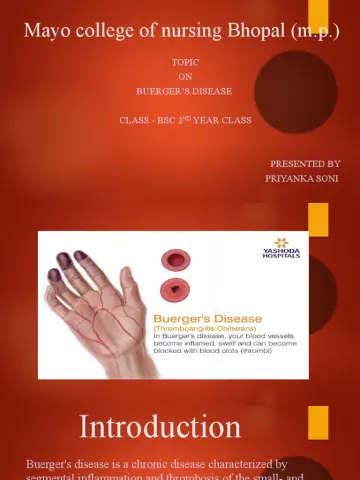- Author Rachel Wainwright [email protected].
- Public 2023-12-15 07:39.
- Last modified 2025-11-02 20:14.
Enterobiasis
General information about the disease

Enterobiasis is an infectious disease characterized by intestinal damage, allergic reactions and severe itching in the anal area. At the moment, enterobiasis is the most common helminthiasis both in Russia and in other countries with a cold, temperate climate. The causative agents of infection - small and thin helminths (pinworms) - live in the intestines.
Most often, enterobiasis affects children aged 3 to 10 years. The peak incidence of enterobiasis in children occurs at 5 years of age. When diagnosed with enterobiasis, treatment is significantly complicated due to the resistance of pathogens to the action of medications, therefore it is highly desirable to observe the rules of personal hygiene of the child and monitor the sanitary conditions in kindergarten, school and at home. Particular attention is paid to bedding, toys, carpets, bathrooms and toilets, since it is these objects and rooms that are the place where pinworms accumulate. Usually enterobiasis in children manifests itself after eating contaminated food or water. Despite regular processing, pathogens survive for some time even in baby bottles and decanters.
How is enterobiasis transmitted?
A sick person is always the source of enterobiasis. Pinworm eggs deposited on the skin surface mature within 4-6 hours and immediately become infectious. They get on bed linen, personal hygiene items, toys, furniture. Pathogens are spread by flies. As for the routes of infection, as a rule, enterobiasis develops after eating untreated foods and water or inhaling dust, which contains helminth eggs. Note also that when diagnosed with enterobiasis, the symptoms of the disease often appear simultaneously in several parts of the body. This is explained by the actions of the patient himself, who combs the itchy areas and transfers pathogens to healthy skin, contributing to their re-entry into the intestines.
A few words about the consequences of enterobiasis. Once in the human body, helminths cause mechanical damage to the skin and mucous membranes of organs, which leads to inflammatory processes and the development of allergic reactions. In women, female pinworms often enter the genitals.
Symptoms of the disease of enterobiasis
The onset of symptoms of enterobiasis is noted 1.5-2 weeks after infection. It is during this period that pinworms reach a sexually mature state and begin their destructive activity. The main symptom of enterobiasis is severe itching in the anal area. It usually lasts for several days, and then weakens, in order to assert itself with a vengeance in 3-4 weeks. As the pathogens accumulate in the intestines, itching becomes permanent and becomes very painful. Combing the damaged areas only leads to the re-entry of helminths into the intestines, abrasions, dermatitis and the addition of secondary infections. If there is suspicion of enterobiasis, an analysis for the presence of helminths should be carried out as soon as possible. Otherwise,to the constant itching, other characteristic symptoms of enterobiasis of the infection will also be added:
- stomach ache;
- inflammatory diseases of the gastrointestinal tract;
- vomiting, nausea;
- disturbed sleep, fatigue;
- allergic reactions;
- urinary tract infections;
- enterobiasis in children leads to a lag in height and weight;
- women often have inflammation of the vaginal mucosa.
It should be noted that over the years of constant existence next to humans, the causative agents of enterobiasis have perfectly adapted to life in the body of carriers and have learned to counteract many medications. Enterobiasis often proceeds without pronounced clinical signs, and the existing symptoms coincide with the manifestations of other helminthiasis. For this reason, the only way to detect enterobiasis in time is the analysis of feces of a sick person and other laboratory research methods.
Treatment of enterobiasis

The course of treatment is inseparable from the careful observance of personal hygiene and disinfection of things with which the patient came into contact. It should also be borne in mind that preventive treatment of enterobiasis is necessary for all members of the family or children's team, since the infection can be latent.
When treating enterobiasis, the following sanitary and hygienic measures are taken at home:
- bed linen is boiled for half an hour, and then thoroughly ironed on both sides;
- wet cleaning is carried out in all rooms of the apartment using disinfecting detergents;
- during cleaning, special attention is paid to door handles, dressing room, hallway;
- if enterobiasis is observed in a child, it is necessary to wash all the baby's toys and other objects with which he often comes into contact with soap;
- if there are carpets and rugs in the house, then you should vacuum them, and then wet the coatings outside.
A complex of disinfecting measures is carried out twice - at the beginning of the course of treatment and 2 weeks after the first cleaning.
As for medications. In case of enterobiasis, children are usually prescribed sparing anthelmintics, for example, mebendazole or pyrantel. They effectively affect both eggs of parasites and sexually mature larvae, disrupt metabolic processes in pinworms, and block the ability of pathogens to adhere to the intestinal membrane. The above drugs are not absorbed into the bloodstream and act only in the intestine itself, which excludes the possibility of allergic reactions to the active components of drugs. Also, with the diagnosis of enterobiasis, treatment involves taking bifidumbacterin, which restores the normal intestinal microflora.
After the end of the course of treatment of enterobiasis, patients undergo a control analysis, which is associated with the long course of the infection and the resistance of pathogens to certain drugs. If necessary, the treatment is repeated with an increase in the dose of drugs, but we note that due to the rapid development of medical technologies, a second course is required only in exceptional cases.
YouTube video related to the article:
The information is generalized and provided for informational purposes only. At the first sign of illness, see your doctor. Self-medication is hazardous to health!






